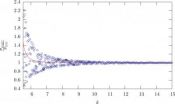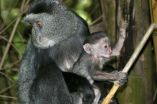(Press-News.org) This press release is available in Spanish.
U.S. Department of Agriculture (USDA) scientists have identified sources of Escherichia coli bacteria that could help restore the reputation of local livestock. Studies by Agricultural Research Service (ARS) scientist Mark Ibekwe suggest that in some parts of California, pathogens in local waterways are more often carried there via runoff from urban areas, not from animal production facilities.
ARS is USDA's chief intramural scientific research agency, and this work supports the USDA priority of ensuring food safety.
Even though most strains of E. coli are non-pathogenic, the bacterium is monitored by public health officials as an indicator of water quality. Cows are often seen as the culprits when E. coli is found in local lakes, rivers and other bodies of water.
Ibekwe, who works at the ARS U.S. Salinity Laboratory in Riverside, Calif., and his colleagues collected 450 water and sediment samples from 20 sites throughout California's middle Santa Ana River Watershed. The collection sites included urban areas, livestock feeding areas, parks, National Forest lands, and three wastewater treatment plants.
Then the scientists extracted E. coli bacteria from each sample and identified 600 different isolates of E. coli in their samples, many of which could be placed into six clonal populations. They found the greatest variety of different types of E. coli in runoff discharged from areas dominated by urban development or human activities.
Ibekwe also tested all the E. coli isolates for resistance to various antibiotics. He found that from 88 to 95 percent of the isolates were resistant to rifampicin, and that around 75 percent were resistant to tetracycline. Tetracycline resistance was by far the most common type of resistance observed in E. coli isolates collected near wastewater treatment plants.
The scientists also found that 24 percent of E. coli collected in sediment samples associated with urban runoff—a total of 144 isolates—showed resistance to as many as seven antibiotics. Results from this work were published in PLOS ONE.
###
Read more about this work in the November/December 2012 issue of Agricultural Research magazine.
http://www.ars.usda.gov/is/AR/archive/nov12/Ecoli1112.htm
USDA is an equal opportunity provider and employer. To file a complaint of discrimination, write: USDA, Office of the Assistant Secretary for Civil Rights, Office of Adjudication, 1400 Independence Ave., SW, Washington, DC 20250-9410 or call (866) 632-9992 (Toll-free Customer Service), (800) 877-8339 (Local or Federal relay), (866) 377-8642 (Relay voice users).
Sources of E. coli are not always what they seem
2012-11-29
ELSE PRESS RELEASES FROM THIS DATE:
The beginning of everything: A new paradigm shift for the infant universe
2012-11-29
A new paradigm for understanding the earliest eras in the history of the universe has been developed by scientists at Penn State University. Using techniques from an area of modern physics called loop quantum cosmology, developed at Penn State, the scientists now have extended analyses that include quantum physics farther back in time than ever before -- all the way to the beginning. The new paradigm of loop quantum origins shows, for the first time, that the large-scale structures we now see in the universe evolved from fundamental fluctuations in the essential quantum ...
Precisely engineering 3-D brain tissues
2012-11-29
CAMBRIDGE, MA -- Borrowing from microfabrication techniques used in the semiconductor industry, MIT and Harvard Medical School (HMS) engineers have developed a simple and inexpensive way to create three-dimensional brain tissues in a lab dish.
The new technique yields tissue constructs that closely mimic the cellular composition of those in the living brain, allowing scientists to study how neurons form connections and to predict how cells from individual patients might respond to different drugs. The work also paves the way for developing bioengineered implants to replace ...
Running too far, too fast, and too long speeds progress 'to finish line of life'
2012-11-29
Vigorous exercise is good for health, but only if it's limited to a maximum daily dose of between 30 and 50 minutes, say researchers in an editorial published online in Heart.
The idea that more and more high intensity exercise, such as marathons, can only do you good, is a myth say the US cardiologists, and the evidence shows that it's likely to more harm than good to your heart.
"If you really want to do a marathon or full distance triathlon, etc, it may be best to do just one or a few and then proceed to safer and healthier exercise patterns," they warn.
"A routine ...
Can a genetic variation in the vitamin D receptor protect against osteoporosis?
2012-11-29
New Rochelle, NY, November 29, 2012—Osteoporosis, or reduced bone mineral density that can increase the risk of fractures, may affect as many as 30% of women and 12% of men worldwide. One risk factor for osteoporosis is vitamin D deficiency. A modified form of the vitamin D receptor present in some individuals may lower their risk for developing osteoporosis, according to an article in Genetic Testing and Molecular Biomarkers, a peer-reviewed journal from Mary Ann Liebert, Inc., publishers. The article is available on the Genetic Testing and Molecular Biomarkers website.
To ...
Post-divorce journaling may hinder healing for some
2012-11-29
Following a divorce or separation, many people are encouraged by loved ones or health-care professionals to keep journals about their feelings. But for some, writing in-depth about those feelings immediately after a split may do more harm than good, according to new research.
In a study of 90 recently divorced or separated individuals, psychological scientist David Sbarra of the University of Arizona and colleagues found that writing about one's feelings can actually leave some people feeling more emotionally distraught months down the line, particularly those individuals ...
Drug may offer new approach to treating insomnia
2012-11-29
MINNEAPOLIS – A new drug may bring help for people with insomnia, according to a study published in the November 28, 2012, online issue of Neurology®, the medical journal of the American Academy of Neurology.
The drug, suvorexant, blocks the chemical messengers in the brain called orexins, which regulate wakefulness. Other drugs for insomnia affect different brain receptors.
Taking the drug suvorexant increased the amount of time people spent asleep during the night, according to the study. The study involved 254 people ages 18 to 64 who were in good physical and ...
Tiny algae shed light on photosynthesis as a dynamic property
2012-11-29
One of the first chemical reactions children learn is the recipe for photosynthesis, combining carbon dioxide, water and solar energy to produce organic compounds. Many of the world's most important photosynthetic eukaryotes such as plants did not develop the ability to combine these ingredients themselves. Rather, they got their light-harnessing organelles -- chloroplasts -- indirectly by stealing them from other organisms. In some instances, this has resulted in algae with multiple, distinct genomes, the evolutionary equivalent of a "turducken*."
Chloroplasts originally ...
Morality-based judgments are quicker, more extreme than practical evaluations
2012-11-29
Judgments made after a moral evaluation are quicker and more extreme than the same judgment based on practical considerations, but morality-based evaluations can be more easily shifted and made with other considerations in mind, according to research published November 28 in the open access journal PLOS ONE by Jay Van Bavel and colleagues from New York University.
Previous research has suggested that moral reasoning usually occurs after a person makes a decision, as a post hoc justification of their choice, rather than the basis for the decision itself. This new study ...
More omnivore dilemmas: Seasonal diet changes can cause reproductive stress in primates
2012-11-29
When seasonal changes affect food availability, omnivores like blue monkeys adapt by changing their diets, but such nutritional changes may impact female reproduction, according to research published November 28 in the open access journal PLOS ONE by Steffen Foerster from Barnard College, and colleagues from Columbia University and the Smithsonian Institution.
The authors found that levels of fecal glucocorticoids (fGC), a stress marker, increased when female monkeys shifted their diet towards lower quality fallback foods, whereas the levels decreased when the monkeys ...
Skeletons in cave reveal Mediterranean secrets
2012-11-29
Skeletal remains in an island cave in Favignana, Italy, reveal that modern humans first settled in Sicily around the time of the last ice age and despite living on Mediterranean islands, ate little seafood. The research is published November 28 in the open access journal PLOS ONE by Marcello Mannino and colleagues from the Max Planck Institute for Evolutionary Anthropology, Germany.
Genetic analysis of the bones discovered in caves on the Egadi islands provides some of the first mitochondrial DNA data available for early humans from the Mediterranean region, a crucial ...


